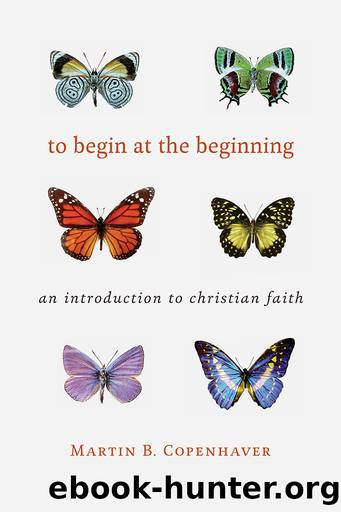To Begin at the Beginning by Copenhaver Martin B.;

Author:Copenhaver, Martin B.;
Language: eng
Format: epub
Publisher: Wm. B. Eerdmans Publishing Co.
CHAPTER 8
Baptism with Water and the Spirit
This is how William Willimon describes a baptism in a typical American church in the late twentieth century:
A young mother phones the church office and asks to have her new baby âdoneâ next Sunday. One of the babyâs aunts will be in town that weekend and it would be nice to have her there. The pastor hesitates for a few moments before responding, since he only sees the babyâs mother in church occasionally and has yet to meet the father whom the mother describes as ânot the church going type.â But, since everybody will be in town this weekend and since the pastor feels that he could not begin to explain to the couple why he feels uncomfortable baptizing their baby, the pastor agrees to âdoâ the baby during the next Sundayâs service.
âWeâre already having a rather full service next Sunday because weâre in the middle of our fall stewardship emphasis and the choir has planned two anthems. Maybe we ought simply to do it after the service rather than unduly prolong things,â says the pastor. âOh well, we can wedge the sprinkling in during the first part of the serviceâbefore the baby gets restless. You bring her down Sunday.â1
Baptism was not always done this way. Hippolytus, who lived in the third century and was known as the âchief of the bishops of Rome,â gives a full description of baptism in the early church that reveals some of the differences. Those desiring to be baptized would spend three years as catechumens (that is, âhearersâ), during which time they would be guided through an arduous process of instruction and examination. During this period, the primary emphasis was disciplined training into the ethical expectations of the church. It was assumed that entrance into the church necessarily involved a change of lifestyle and behavior. Candidates had to show evidence of conversion (literally, a âturnaroundâ).
During this period, catechumens were allowed to attend the first part of Sunday worship, in which the Scripture was read and the sermon was preached, but they were dismissed before the Lordâs Supper, and they were not allowed to pray with the faithful. Almost three years later, catechumens were examined. This examination was not a matter of providing right answers, but of living righteous lives. The elders of the church were interested in knowing if the catechumens were sharing with those in need, visiting the sick, and in other ways fulfilling the demands on those who would follow Jesus. Those who passed the examination were admitted as candidates for baptism.
A few weeks before Easter, the instruction turned from moral instruction to teaching about the gospel. Having been attracted to the life exhibited by those who followed Jesus, the candidates were now invited to drink deeply from the same source. It was a period of intense preparation. They were led in the study of Scripture and explanation of the Apostlesâ Creed. They fasted regularly. On Good Friday the candidates entered a strict fast that did not end until Easter morning.
Download
This site does not store any files on its server. We only index and link to content provided by other sites. Please contact the content providers to delete copyright contents if any and email us, we'll remove relevant links or contents immediately.
Liberal Arts for the Christian Life by Jeffry C. Davis(65)
To Begin at the Beginning by Copenhaver Martin B.;(65)
Stay in the City by Gornik Mark R.;Wong Maria Liu;Keller Timothy;Acevedo Peter & Miriam Yvette;(64)
Teaching the Faith, Forming the Faithful by Parrett Gary A.;Kang S. Steve;Packer J. I.;(60)
Processing the Plan of God Through Prayer by Mark Brazee(58)
Approaching the Study of Theology: An Introduction To Key Thinkers, Concepts, Methods And Debates by Anthony C. Thiselton(51)
Principles of Catholic Social Teaching by David A. Boileau(50)
Why Do We Suffer and Where Is God When We Do? by Valerie G. Rempel(45)
Two Tasks by Charles Malik(44)
Life Explore Soul by Sakulchai Sikitikul(39)
God's Greater Glory by Bruce A. Ware(27)
